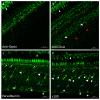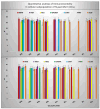Neurotrophins and Trk Neurotrophin Receptors in the Retina of Adult Killifish (Nothobranchius guentheri)
- PMID: 38473977
- PMCID: PMC10932081
- DOI: 10.3390/ijms25052732
Neurotrophins and Trk Neurotrophin Receptors in the Retina of Adult Killifish (Nothobranchius guentheri)
Abstract
Specific subpopulations of neurons in nerve and sensory systems must be developed and maintained, and this is accomplished in significant part by neurotrophins (NTs) and the signaling receptors on which they act, called tyrosine protein kinase receptors (Trks). The neurotrophins-tyrosine protein kinase receptors (NTs/Trks) system is involved in sensory organ regulation, including the visual system. An NTs/Trks system alteration is associated with neurodegeneration related to aging and diseases, including retinal pathologies. An emergent model in the field of translational medicine, for instance, in aging study, is the annual killifish belonging to the Nothobranchius genus, thanks to its short lifespan. Members of this genus, such as Nothobranchius guentheri, and humans share a similar retinal stratigraphy. Nevertheless, according to the authors' knowledge, the occurrence and distribution of the NTs/Trks system in the retina of N. guentheri has never been investigated before. Therefore, the present study aimed to localize neurotrophin BDNF, NGF, and NT-3 and TrkA, TrkB, and TrkC receptors in the N. guentheri retina using the immunofluorescence method. The present investigation demonstrates, for the first time, the occurrence of the NTs/Trks system in N. guentheri retina and, consequently, the potential key role of these proteins in the biology and survival of the retinal cells.
Keywords: N. guentheri; Trks; neurotrophins; retina; translational medicine.
Conflict of interest statement
The authors declare no conflicts of interest.
Figures







Similar articles
-
Localization of Neurotrophin Specific Trk Receptors in Mechanosensory Systems of Killifish (Nothobranchius guentheri).Int J Mol Sci. 2021 Sep 27;22(19):10411. doi: 10.3390/ijms221910411. Int J Mol Sci. 2021. PMID: 34638748 Free PMC article.
-
Expression of neurotrophins and their receptors in peripheral lung cells of mice.Histochem Cell Biol. 2002 Jul;118(1):51-8. doi: 10.1007/s00418-002-0426-y. Epub 2002 Jun 12. Histochem Cell Biol. 2002. PMID: 12122447
-
Localization of Calretinin, Parvalbumin, and S100 Protein in Nothobranchius guentheri Retina: A Suitable Model for the Retina Aging.Life (Basel). 2023 Oct 13;13(10):2050. doi: 10.3390/life13102050. Life (Basel). 2023. PMID: 37895432 Free PMC article.
-
Role of neurotrophins and trk receptors in the development and maintenance of sensory neurons: an overview.Philos Trans R Soc Lond B Biol Sci. 1996 Mar 29;351(1338):365-73. doi: 10.1098/rstb.1996.0030. Philos Trans R Soc Lond B Biol Sci. 1996. PMID: 8730773 Review.
-
Neurotrophins in cultured cells from periodontal tissues.J Periodontol. 2003 Jan;74(1):76-84. doi: 10.1902/jop.2003.74.1.76. J Periodontol. 2003. PMID: 12593600 Review.
Cited by
-
Urtica dioica Extract Abrogates Chlorpyrifos-Induced Toxicity in Zebrafish Larvae.Int J Mol Sci. 2024 Jun 16;25(12):6631. doi: 10.3390/ijms25126631. Int J Mol Sci. 2024. PMID: 38928336 Free PMC article.
References
-
- Nikiforov-Nikishin D.L., Irkha V.A., Kochetkov N.I., Kalita T.L., Nikiforov-Nikishin A.L., Blokhin E.E., Antipov S.S., Makarenkov D.A., Zhavnerov A.N., Glebova I.A., et al. Some Aspects of Development and Histological Structure of the Visual System of Nothobranchius guentheri. Animals. 2021;11:2755. doi: 10.3390/ani11092755. - DOI - PMC - PubMed
-
- Ostrander G.K., Hopkins J. The Laboratory Fish. Elsevier; Amsterdam, The Netherlands: 2000.
-
- García-Suárez O., Germanà A., Hannestad J., Pérez-Pérez M., Esteban I., Naves F.J., Vega J.A. Changes in the expression of the nerve growth factor receptors TrkA and p75LNGR in the rat thymus with ageing and increased nerve growth factor plasma levels. Cell Tissue Res. 2000;301:225–234. doi: 10.1007/s004419900133. - DOI - PubMed
MeSH terms
Substances
Supplementary concepts
LinkOut - more resources
Full Text Sources
Research Materials

